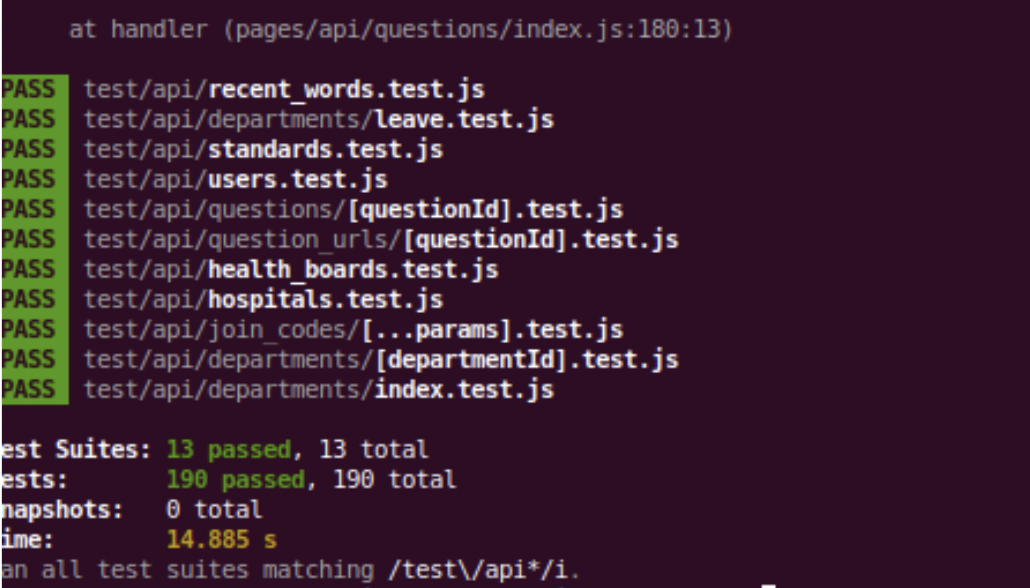TESTING
FRONT-END TESTING
After doing some research on how to test React and Next.js projects we learnt that a common method is by utilising
Jest and Enzyme. Enzyme allows us to manipulate or use components in our test suite using built-in methods such
as mount (to simulate a component for testing purposes) and simulate (to simulate interactions with components like clicks). Jest, on the other hand, is an assertion library and test runner. It is an open source JavaScript testing framework
which is very well documented and has a wide range of APIs which gives us great flexibility to test in a variety of different ways. Another advantage of Jest is that tests are isolated and can be parallelized which allowed us to create a huge
test suite that can be run in seconds. For testing our front-end, we had created 22 test suites with 71 tests in total. After running them, we managed to pass all 71 tests as seen in the diagram below:


BACK-END TESTING
Continuing from the previous year's iteration, we decided not to unit test the API, because of the complications that may arise when isolating the logic of the APIs from the network handling and database interactions. Therefore, we will again be performing
integration testing on our REST API to test the Next.js route handling through to the database interactions. We discovered a Node package,
One major problem with the backend testing is that every action creates unnecessary data that could affect other actions further down the line. We want to isolate not units but whole systems/networks to retrieve correct data from the database. This is why we implement a script (

openapi-response that links with jest-openapi to assert HTTP responses to match
our OpenAPI specification. One major benefit being that we can use our OpenAPI specification in part for testing too, so we don't have to write code again to check for response structure when we already have it in our OpenAPI specification.One major problem with the backend testing is that every action creates unnecessary data that could affect other actions further down the line. We want to isolate not units but whole systems/networks to retrieve correct data from the database. This is why we implement a script (
api-test.environment.js) that cleans and add certain seed data for us to use in each test. The script is ran before every test for the system to use and utilises
Jest Test Environments for the teardowns. Overall our back-end struggled with responses and words due to different implementations of the scores and dashboards. However, our dashboard still passed all 190 tests from our 13 test
suites. The results are illustrated in the following diagram: 
END-TO-END TESTING
These aim to test the entire system as a whole from a user’s perspective, by programmatically navigating to the site, interacting with it, and asserting that the UI is updated and functions correctly at all times. We are using Puppeteer, a popular Node.js API to programmatically control Chrome, alongside Jest for these tests. However, Puppeteer does not come with all good things; we found that it is incompatible with our own global variables
that refer to the page and the browser, thus we were limited to what the library gave us. Sometimes we found that the browser environment was not the same on all the machines and we had errors of
Overall we tried to create a codebase that worked on all machines. After setting up the end-to-end testing framework, we began on writing the tests. We focused on covering all functionalities of our platform for ensuring that we were confident of having no bugs and that our platform is fully functional. We did this step-by-step by going through each use case of our platform and noting what actions these may require on our platform. We also focused on testing the security of our platform so we tested whether users with limited permissions could access parts of our platform that require more permissions. With a total of 13 tests, we were able to pass all of them on both Firefox and Chrome complying with compatibility testing as seen in the diagram below:
this.global.page.close cannot
be called as it is undefined in the environment. However, on some machines this would work perfectly. Overall we tried to create a codebase that worked on all machines. After setting up the end-to-end testing framework, we began on writing the tests. We focused on covering all functionalities of our platform for ensuring that we were confident of having no bugs and that our platform is fully functional. We did this step-by-step by going through each use case of our platform and noting what actions these may require on our platform. We also focused on testing the security of our platform so we tested whether users with limited permissions could access parts of our platform that require more permissions. With a total of 13 tests, we were able to pass all of them on both Firefox and Chrome complying with compatibility testing as seen in the diagram below:
